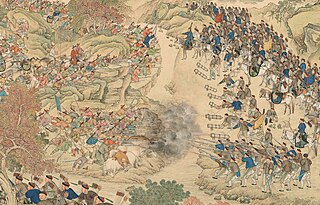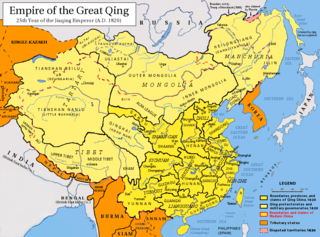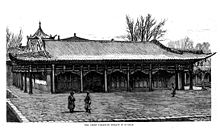
The Uyghurs, alternatively spelled Uighurs, Uygurs or Uigurs, are a Turkic ethnic group originating from and culturally affiliated with the general region of Central and East Asia. The Uyghurs are recognized as the titular nationality of the Xinjiang Uyghur Autonomous Region in Northwest China. They are one of China's 55 officially recognized ethnic minorities. The Uyghurs are recognized by the Chinese government as a regional minority and the titular people of Xinjiang.

The Dzungar Khanate, also written as the Zunghar Khanate or Junggar Khanate, was an Inner Asian khanate of Oirat Mongol origin. At its greatest extent, it covered an area from southern Siberia in the north to present-day Kyrgyzstan in the south, and from the Great Wall of China in the east to present-day Kazakhstan in the west. The core of the Dzungar Khanate is today part of northern Xinjiang, also called Dzungaria.

The Tarim Basin is an endorheic basin in Xinjiang, Northwestern China occupying an area of about 888,000 km2 (343,000 sq mi) and one of the largest basins in Northwest China. Located in China's Xinjiang region, it is sometimes used synonymously to refer to the southern half of the province, that is, Southern Xinjiang or Nanjiang, as opposed to the northern half of the province known as Dzungaria or Beijiang. Its northern boundary is the Tian Shan mountain range and its southern boundary is the Kunlun Mountains on the edge of the Tibetan Plateau. The Taklamakan Desert dominates much of the basin. The historical Uyghur name for the Tarim Basin is Altishahr, which means 'six cities' in Uyghur. The region was also called Little Bukhara or Little Bukharia.

Dzungaria, also known as Northern Xinjiang or Beijiang, is a geographical subregion in Northwest China that corresponds to the northern half of Xinjiang. Bound by the Altai Mountains to the north and the Tian Shan mountain range to the south, Dzungaria covers approximately 777,000 km2 (300,000 sq mi), and borders Kazakhstan to the west and Mongolia to the east. In contexts prior to the mid-18th century Dzungar genocide, the term "Dzungaria" could cover a wider area, coterminous with the Oirat-led Dzungar Khanate.

The East Turkestan independence movement is a political movement that seeks the independence of East Turkestan, a large and sparsely-populated region in northwest China, as a nation state for the Uyghur people. The region is currently administered as a province-level subdivision of the People's Republic of China (PRC), under the official name Xinjiang Uygur Autonomous Region (XUAR). Within the movement, there is widespread support for the region to be renamed, since "Xinjiang" is seen by independence activists as a colonial name. "East Turkestan" is the best-known proposed name as it is the historical geographic name of the region and the name of the two independent states that briefly existed in the region in the first half of the 20th century.

Xinjiang is historically consisted of two main geographically, historically, and ethnically distinct regions with different historical names: Dzungaria north of the Tianshan Mountains; and the Tarim Basin south of the Tianshan Mountains, currently mainly inhabited by the Uyghurs. They were conquered by the Qing dynasty in the 18th century, and after the Dungan Revolt (1862–1877) the Qing reconquered both regions and integrated them into one province named Xinjiang in 1884.

During the Manchu-led Qing dynasty (1636–1912), Islam was a significant religion in Northwestern China and Yunnan. There were five major Muslim rebellions during the Qing period. The first and last rebellions were caused by sectarian infighting between rival Sufi Muslim orders.

The Dzungar people are the many Mongol Oirat tribes who formed and maintained the Dzungar Khanate in the 17th and 18th centuries. Historically, they were one of the major tribes of the Four Oirat confederation. They were also known as the Eleuths or Ööled, from the Qing dynasty euphemism for the hated word "Dzungar", and as the "Kalmyks". In 2010, 15,520 people claimed "Ööled" ancestry in Mongolia. An unknown number also live in China, Russia and Kazakhstan.

Xinjiang, officially the Xinjiang Uygur Autonomous Region, is an autonomous region of the People's Republic of China (PRC), located in the northwest of the country at the crossroads of Central Asia and East Asia. Being the largest province-level division of China by area and the 8th-largest country subdivision in the world, Xinjiang spans over 1.6 million square kilometres (620,000 sq mi) and has about 25 million inhabitants. Xinjiang borders the countries of Afghanistan, Kazakhstan, Kyrgyzstan, Mongolia, Pakistan, Russia, Tajikistan, and India. The rugged Karakoram, Kunlun and Tian Shan mountain ranges occupy much of Xinjiang's borders, as well as its western and southern regions. The Aksai Chin and Trans-Karakoram Tract regions are administered by China but also claimed by India. Xinjiang also borders the Tibet Autonomous Region and the provinces of Gansu and Qinghai. The most well-known route of the historic Silk Road ran through the territory from the east to its northwestern border.

The Kumul Khanate was a semi-autonomous feudal Turco-Mongol khanate within the Qing dynasty and then the Republic of China until it was abolished by Xinjiang governor Jin Shuren in 1930. The khanate was located in present-day Hami prefecture of Xinjiang.

The Dzungar–Qing Wars were a decades-long series of conflicts that pitted the Dzungar Khanate against the Qing dynasty and its Mongol vassals. Fighting took place over a wide swath of Inner Asia, from present-day central and eastern Mongolia to Tibet, Qinghai, and Xinjiang regions of present-day China. Qing victories ultimately led to the incorporation of Outer Mongolia, Tibet and Xinjiang into the Qing Empire that was to last until the fall of the dynasty in 1911–1912, and the genocide of much of the Dzungar population in the conquered areas.

The Revolt of the Altishahr Khojas was an uprising against the Qing dynasty of China, which broke out in 1757 during the reign of the Qianlong Emperor. The rebels were led by Khwāja-i Jahān, leader of the White Mountain Sufis. Qing era documents refer to the event as the "Pacification of the Muslim regions". Hojijan and his brother, Burhān al-Dīn, both held the Muslim title Khoja.

Migration to Xinjiang is both an ongoing and historical movement of people, often sponsored by various states who controlled the region, including the Han dynasty, Qing dynasty, Republic of China and People's Republic of China.

Altishahr, also known as Kashgaria, is a historical name for the Tarim Basin region used in the 18th and 19th centuries. The term means "Six Cities" in Turkic languages, referring to oasis towns along the rim of the Tarim, including Kashgar, in what is now southern Xinjiang Uyghur Autonomous Region of China.

The Dzungar genocide was the mass extermination of the Mongol Dzungar people by the Qing dynasty. The Qianlong Emperor ordered the genocide after the rebellion in 1755 by Dzungar leader Amursana against Qing rule, after the dynasty first conquered the Dzungar Khanate with Amursana's support. The genocide was perpetrated by Manchu generals of the Qing army, supported by Turkic oasis dwellers who rebelled against Dzungar rule.
The Dzungar conquest of Altishahr resulted in the Tibetan Buddhist Dzungar Khanate in Dzungaria conquering and subjugating the Genghisid-ruled Yarkent Khanate in Altishahr. It put a final end to the independence of the Chagatai Khanate.
Anti-Mongolianism, also called the Anti-Mongolian sentiment has been prevalent throughout history, often perceiving the Mongols to be barbaric and uncivilized people with a lack of intelligence or civilized culture.

The Qing dynasty in Inner Asia was the expansion of the Qing dynasty's realm in Inner Asia in the 17th and the 18th century AD, including both Inner Mongolia and Outer Mongolia, both Manchuria and Outer Manchuria, Tibet, Qinghai and Xinjiang.

The Manchu-led Qing dynasty of China ruled over Xinjiang from the late 1750s to 1912. In the history of Xinjiang, the Qing rule was established in the final phase of the Dzungar–Qing Wars when the Dzungar Khanate was conquered by the Qing dynasty, and lasted until the fall of the Qing dynasty in 1912. The post of General of Ili was established to govern the whole of Xinjiang and reported to the Lifan Yuan, a Qing government agency that oversaw the empire's frontier regions. Xinjiang was turned into a province in 1884.

In 1759, the Qing dynasty of China defeated the Dzungar Khanate and completed the conquest of Dzungaria. Concurrent with this conquest, the Qing occupied the Altishahr region in modern southern Xinjiang, which had been settled by Muslims who followed the political and religious leadership of Afaq Khoja.

















